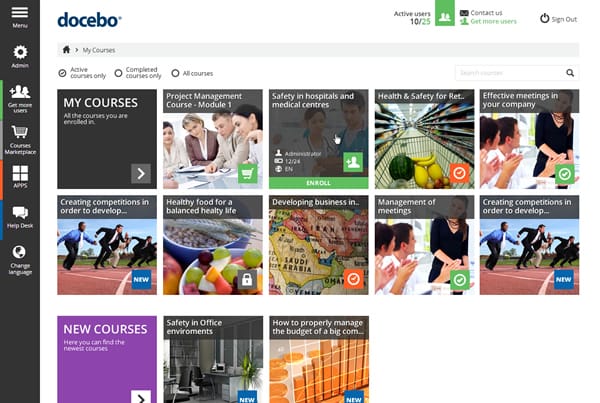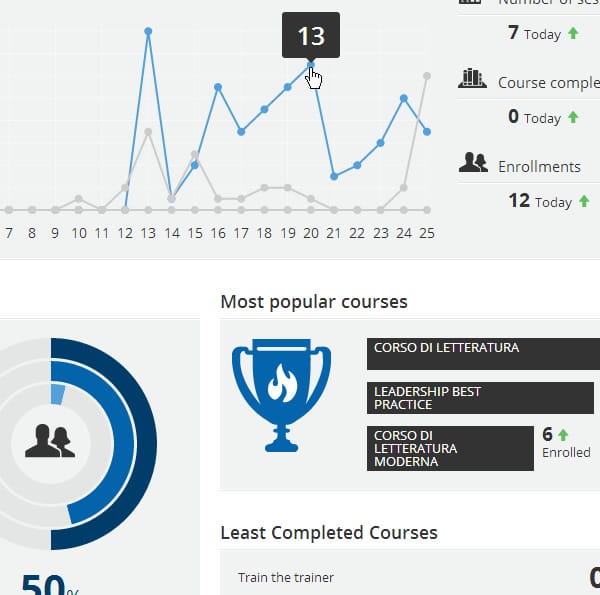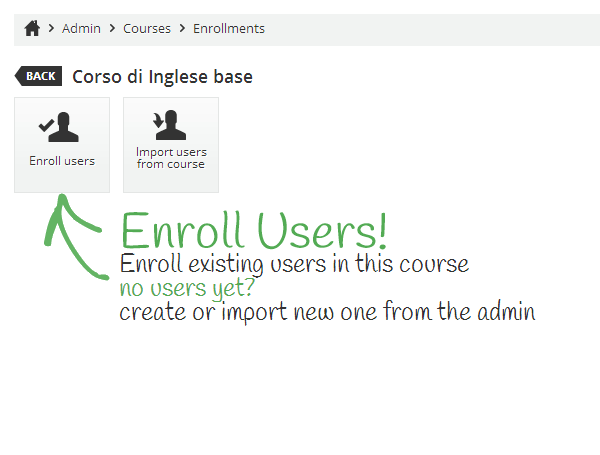Today we have the opportunity to talk a little bit with Andrea Biraghi, Docebo’s Senior Visual Designer, about the new Docebo Learning Management System user interface, that comes with a single-page Web App approach and several critical improvements.
- What inspired you while you designed Docebo’s new LMS?
Surely inspiration is vital for every designer, and is a fundamental part of designing and implementing a user interface.
My biggest concern is working on something that may not be realistic, or that doesn’t fully meet the needs of the users, because technology today changes so quickly and unpredictably. Therefore, it is extremely important to keep your eyes open, and to constantly research and try to innovate. It’s equally important to observe and analyze how competitors move.
This means following those companies that are leaders in this industry, and have created products that affect our day-to-day lives. With that being said, we should not forget those companies that – although less known – have become highly respected for their innovation and disruption in the SAAS market.

I believe that the best path to understanding the reasons behind certain decisions is by adapting these ideas in the business environment. On the other hand, it’s important to create something new that’s both cohesive with what your target audience wants right now, and what will create a demand in the future. You have to make your product both successful, and customer centric.
To conclude, I believe it’s important to observe people around the world who are also working in your field. On websites like Behance, for example, there is a showcase of product designers, who are active in many different industries. It is a great opportunity for me to discover, study, and appreciate their work. Above all, I can analyze and understand where trends are heading. This is probably the right way to develop a global vision, the so-called “360° view”.
- Creativity and style are key elements of the new Docebo. What makes its design different from competitors, and why do you think it is “better”?
There have been such profound improvements since past versions. The first thing, and the one that concerns me the most, is the appearance: the interface has been completely rethought and redesigned.
We wanted to create a totally new learning environment characterized by a new design, and a minimal style. At the same time, it was critical to create a user experience that allowed the user to focus on the learning objects.
What clearly distinguishes us from our competitors is the single-page app approach. This means that we can provide our customers with a single page for both the administrators, and the users. This page can be accessed through a simple and intuitive interface, allowing users immediate access to any learning resources within a course.

With this logic flow, you can look at course information, and manage the various widgets or modules in a style that is similar to the Facebook wall. Secondly, we have introduced a new main menu that includes the features of the platform in a single area. Courses and student reports have been improved and redesigned to be intuitive, and easy to manage.
Finally, we have revised several users’ processes, in order to support every kind of learner. This way, we’re able to follow a natural flow to reach a certain educational goal. To achieve this goal, we have created a real-time help and guidance system that explains what a given function means and how it works.
Visual aids will now guide you through instructions when performing specific tasks for the first time. The first access into the platform, and the first course setup or users enrollment procedures are some examples of what you’ll see now.
- What goals do you have when you prepare to design a new product?
First of all, we need to analyze and understand who will be using the product, and identify their needs.
In the E-Learning niche, it is not simple at all. E-Learning platforms are used by an extremely diverse, and broad audience. Unlike other products or software that have a very limited and technical audience, an E- Learning Management System can potentially be used by everybody.

A LMS user could be a highly qualified computer systems technician, or a novice to the technology domain. The E-Learning course should reach a broad spectrum of personalities.
It is therefore vital to set goals, and have a clear and concise vision about creating a functional learning environment.
- While developing the idea of a new product, do you prefer to “fix a problem” or to “create” out of pure innovation, and intuition?
That’s a very good question. Let me put it in this way: every time I design a graphic interface for our product, I always fix a problem based on specific needs.
However, what fascinates me the most about my work is to study and enable the best behavior for users. This allows me to help them identify an ideal manner to overcome any obstacle.

The greatest designers confirm that the real challenge is not only to design products that are both beautiful and impactful, but also able to be understood from the user. This brings the user to really enjoy a product. I believe this approach, applied to a product like Docebo, is top priority.
About Andrea Biraghi – Senior Visual Designer – Docebo
Andrea Biraghi works in the following visual design and communication fields: Web Design, Graphic User Interface, User Experience/Web Communication, Interaction Design, Content Design, Graphic design, Online marketing and SEO, both in Italy and Abroad.
Since 2003 he works for Docebo s.r.l. He develops layouts, web interfaces, web contents for the corporate website and for the internal products, both on the graphical side and the communication/user experience side (UI & UX). On top of this, he creates web and traditional products for the internal marketing.
Past activities:
- Co-founder (with several other design specialists) at Sayonara Rush, a creative side activity that, between 2007 and 2009, operated in the design and communication fields (furniture, food design, wine design, accessories). Sayonara Rush Design collaborated with many companies in the enology fields, taking part in design competitions and achieving several awards and publications on specific magazines, both in Italy and Abroad.
- Responsible for the web development and the multimedia area at Creber, a graphic, web and design agency. (2004)
- Teacher at two courses about PHPNuke, explaining how to create graphic templates for the content management system. (2003)
- Writer for specific Italian magazines and websites like PC è facile, manuali.net and html.it. (2000-2004)
